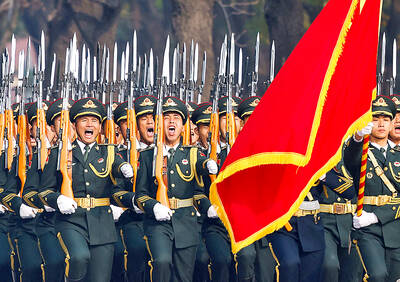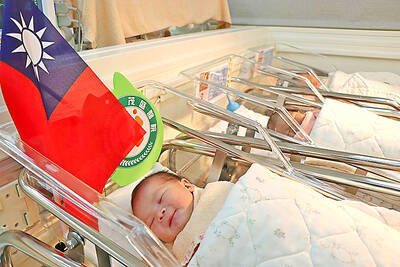Following the recent publication of a New Zealander's account of the 228 Incident and the donation of the original manuscript to the 228 Memorial Museum, critics say the third-party account of the atrocities serves as a unique opportunity for the general public to reflect on the horrors of the past.
Colin Shackleton donated his father's manuscript of his book Formosa Calling to the 228 Memorial Museum on Saturday -- more than five decades after his father Allan James Shackleton wrote about his post-war experiences in Taiwan as a UN rehabilitation officer.
The manuscript describes how the Chinese moved to Taiwan after the KMT's defeat in the Chinese Civil War, how they pillaged the industrial society created by the Japanese on Taiwan and the corruption he witnessed among KMT troops.
After the KMT's arrival in Taiwan (usually, at the time, referred to as the Nationalists), "the Formosans soon found that property was not safe when soldiers were about and that they had no redress at law for any robbery committed by the military," Shackleton wrote in the manuscript.
Lap Phok-bun (
"This is the kind of book that was banned from publication for more than 50 years. More than 50 years later, it has come to light," he added, displaying the Mandarin version of the account, which was published in Taiwan last June.
The English version was only published in 1998.
Unexpected discovery
Before 1997, nobody except Shackleton's family members knew of the existence of the unpublished manuscript, which had been kept in a metal cabin trunk mixed with other documents relating to his experience during WWI.
"After he died, we went through the trunk, and threw out just about everything. But we kept Formosa Calling, and got it moved up into the study into a filing cabinet. It got `promoted,'" said Jenny, Colin Shackleton's wife.
"It's an important part of father's life, so I couldn't have possibly destroyed it," said Colin. Even so, Allan Shackleton's descendents considered the manuscript merely as a family keepsake.
"We didn't consider it important. We thought it's just our family history and that nobody else would be interested," said Jenny.
It was an unexpected telephone call from a stranger in 1997 that changed the fate of the manu-script.
"When I called Colin the first time, he sounded shocked," said Stanley Liao (
Liao said that when preparing an event in New Zealand to mark the 50th anniversary of the 228 Incident in 1997, a friend told him of two New Zealanders he could contact for related materials.
Liao's friend said that George Kerr had mentioned two New Zealanders, Allan James Shackleton and Louise Tomsett, in his 1965 book Formosa Betrayed as sources he consulted about the events of 1947.
Making numerous phone calls, Liao found out that Tomsett, though still alive in Sydney, had suffered a stroke and was unable to speak. Tomsett communicated with Liao via fax to say that all her related files had been lost.
Liao's search for the Shackleton family yielded mixed results. The bad news was that Allan had died in 1984. The good news was that he had left behind him an unpublished manuscript.
"I had absolutely no idea about the manuscript whatsoever before I made the phone call," Liao said.
Liao said it took him sometime to shake off Colin's suspicion about his proposal that the manuscript should be published.
Colin admitted that he was very "careful" when talking to Liao the first few times.
Colin recalled his father's warning given to him in the mid-1980s before the old man passed away.
"Father had once told me, `be very careful, Colin, if you ever go to Taiwan. You may be put in jail on account of the manuscript.' The name Shackleton would be persona non grata in Taiwan because father was known to be against the [KMT] regime," he said.
"So I thought if somebody wanted the manuscript, it could be dangerous," he added, laughing, sitting in his hotel room in downtown Taipei on Thursday evening during his first visit to Taiwan.
Colin said it was Liao's explanation about how limited the related information was that made him change his mind.
"We didn't realize that history was being lost and the document was valuable as a result ... So when [Liao] wanted to have it published, we agreed," he said.
In fact, back at the time when Allan Shackleton endeavored to write about what he witnessed and attempted to have the manuscript published, neither his wife Mildred nor publishers appreciated his effort.
Third party account
But more than a decade after Allan passed away, his battle to publish his account of the bloody uprising in Taiwan was finally won, although it is a delayed victory. When the Mandarin version of the book was published in Taiwan last June, historians like Wu Mi-cha (
Wu, a specialist in Taiwan history at National Taiwan University, said Shackleton's book offered locals a fresh angle on the 1947 tragedy.
"But for these accounts made by foreigners as third parties to the incident, all one can only hear in Taiwan are arguments between victims and persecutors," Wu said.
"Relatives of the victims of the incident will accuse the KMT of atrocities, while the KMT nowadays would say it's a tragedy that happened in the past and they had no part in any misdeeds. A third-party account such as this could enable us to shake off that constraint in looking at history," he said.
He also said third-party accounts would counter government attempts to erase the past.
"These accounts of the events surrounding the incident were valuable because they helped prevent the KMT's attempts to cover up the atrocities. And more than 50 years later, the publication of Shackleton's book can also prevent the KMT from trying to erase memories of past horrors," he added.
As Colin said, "if [the book] helps with the reconciliation process, then it would be of great benefit to the people of Taiwan."

Conflict with Taiwan could leave China with “massive economic disruption, catastrophic military losses, significant social unrest, and devastating sanctions,” a US think tank said in a report released on Monday. The German Marshall Fund released a report titled If China Attacks Taiwan: The Consequences for China of “Minor Conflict” and “Major War” Scenarios. The report details the “massive” economic, military, social and international costs to China in the event of a minor conflict or major war with Taiwan, estimating that the Chinese People’s Liberation Army (PLA) could sustain losses of more than half of its active-duty ground forces, including 100,000 troops. Understanding Chinese

The Ministry of Foreign Affairs (MOFA) yesterday said it is closely monitoring developments in Venezuela, and would continue to cooperate with democratic allies and work together for regional and global security, stability, and prosperity. The remarks came after the US on Saturday launched a series of airstrikes in Venezuela and kidnapped Venezuelan President Nicolas Maduro, who was later flown to New York along with his wife. The pair face US charges related to drug trafficking and alleged cooperation with gangs designated as terrorist organizations. Maduro has denied the allegations. The ministry said that it is closely monitoring the political and economic situation

UNRELENTING: China attempted cyberattacks on Taiwan’s critical infrastructure 2.63 million times per day last year, up from 1.23 million in 2023, the NSB said China’s cyberarmy has long engaged in cyberattacks against Taiwan’s critical infrastructure, employing diverse and evolving tactics, the National Security Bureau (NSB) said yesterday, adding that cyberattacks on critical energy infrastructure last year increased 10-fold compared with the previous year. The NSB yesterday released a report titled Analysis on China’s Cyber Threats to Taiwan’s Critical Infrastructure in 2025, outlining the number of cyberattacks, major tactics and hacker groups. Taiwan’s national intelligence community identified a large number of cybersecurity incidents last year, the bureau said in a statement. China’s cyberarmy last year launched an average of 2.63 million intrusion attempts per day targeting Taiwan’s critical

AGING: As of last month, people aged 65 or older accounted for 20.06 percent of the total population and the number of couples who got married fell by 18,685 from 2024 Taiwan has surpassed South Korea as the country least willing to have children, with an annual crude birthrate of 4.62 per 1,000 people, Ministry of the Interior data showed yesterday. The nation was previously ranked the second-lowest country in terms of total fertility rate, or the average number of children a woman has in her lifetime. However, South Korea’s fertility rate began to recover from 2023, with total fertility rate rising from 0.72 and estimated to reach 0.82 to 0.85 by last year, and the crude birthrate projected at 6.7 per 1,000 people. Japan’s crude birthrate was projected to fall below six,